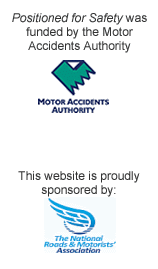MCC Strategies
2.1 Road fixtures and furniture may create crash and injury risks for motorcyclists.
2.1.1 MCC to develop a program to promote the systematic reduction in the number of utility poles and signposts in the road environment.
2.1.2 MCC to work collaboratively with RTA to determine the extent of motorcycle crashes involving different types of roadside objects (e.g. crash barriers, roadside poles, etc.).
2.1.3 MCC to work collaboratively with the RTA on implementing guidelines for clear zones on existing roads to maximise safe recovery area. This should include:
requiring safety barriers, light poles, signposts and other road furniture to be placed as far away from the roadside as possible
promoting the increased usage of multi-purpose poles and mast arms for traffic lights.
- ensuring flat, smooth surfaces for barriers, e.g. concrete or water-filled barriers.
2.1.4 MCC to request Austroads to proceed with the proposed motorcycle roadside crash study on the relative safety risks of different styles of safety barrier to motorcyclists.
2.1.5 MCC to work collaboratively with the RTA and industry to undertake crash testing (computer modelling) of motorcycles into crash barriers.
2.1.6 MCC to work collaboratively with the RTA to develop criteria for motorcycle-friendly safety barriers (e.g. similar to those used in France and Spain).
2.2 Maintenance and upgrading practices may create crash and injury risks for motorcyclists.
2.2.1 MCC to work with the RTA to establish a protocol requiring engineers with motorcycle expertise to be consulted about proposed works programs to address motorcycle safety.
2.2.2 MCC to work with the RTA to assess and report on the risks associated with road maintenance standards for road authorities and engineers.
2.2.3 MCC to work with the NSW Streets Opening Conference (SOC) to ensure restoration practices are safe for motorcyclists. This may include the MCC making a presentation to a meeting of the Streets Opening Conference to raise their awareness of these issues.
2.2.4 MCC to work with other stakeholders (WorkCover, RTA, etc.) to establish procedures to ensure compliance with guidelines and standards at construction and maintenance work sites, including:
raising awareness of motorcycle hazards as a liability risk under OH&S at work sites (e.g. loose gravel or inappropriately placed barriers leading to a crash)
- researching and promoting awareness of local governments’ liability and individual employees’ liability for work that results in motorcycle crashes and injury.
2.2.5 MCC to work with road authorities to develop:
an improved standard for thermoplastics and paint for slip-resistant road markings.
- technical guidelines on the use of crack sealant and standards for skid resistance.
2.3 The designers of new roads are not required to consider the specific vulnerabilities of motorcyclists.
2.3.1 MCC to work with the RTA to provide road engineers with a means of determining motorcycle-specific crash and countermeasure costs and budget implications in the short and long term.
2.3.2 MCC to request that the RTA to revise the RTA Road Design Guide:
to provide information on motorcycle safety requirements to complement that provided for pedestrian and pedal cycle safety.
- to be made available on the internet.
2.3.3 MCC to request that Austroads provide assurance that the interests of minority road users (motorcyclists and pedal cyclists) will not be disadvantaged by the decision to cease production of guides for specific road users.
2.3.4 MCC to request that Austroads ensure the revision of codes and guides for road design, road safety, etc., allow for input from motorcycle safety experts.
2.3.5 MCC to work with the RTA and the Institute of Public Works Engineering Australia (IPWEA) to improve communications with road engineers and authorities about road environment issues affecting motorcycle safety. This may include:
including motorcycle safety-related courses and integrating motorcycle safety issues into existing courses
developing a video/PowerPoint presentation package about road surface and maintenance practices that present hazards for motorcyclists. The package should be stand-alone and designed as a training resource for RTA and local government road works staff and contractors
developing a communications strategy to counter the perception of some road engineers that motorcyclists are only a small proportion of road users and therefore not a high priority (e.g. ‘Riders can’t expect road built to their standards’ or ‘Building better roads just encourages riders to go faster’)
- working with the Australian Institute of Traffic Planning and Management (AITPM) to identify roads and traffic engineers with an interest/expertise in motorcycle safety.
2.4 Crash records are not used systematically to monitor and guide road maintenance practices.
2.4.1 MCC to request the Australian Transport Safety Bureau (ATSB) to assign specific funding for motorcycle black spot programs, recognising that motorcycle crashes are less likely to meet the current criteria for defining a black spot.
2.4.2 MCC to work with the RTA to develop a program of using crash data to identify routes or sites that represent a higher crash risk for motorcyclists, and recommending these sites for remediation work.
2.4.3 MCC to work with the RTA to use dynamic activated signs on major motorcycle routes and black spots.
2.4.4 MCC to encourage and facilitate hazard reporting to road authorities.
2.4.5 MCC to work with road authorities to establish a protocol to conduct compulsory investigations at the sites of all serious and fatal motorcycle crashes.

